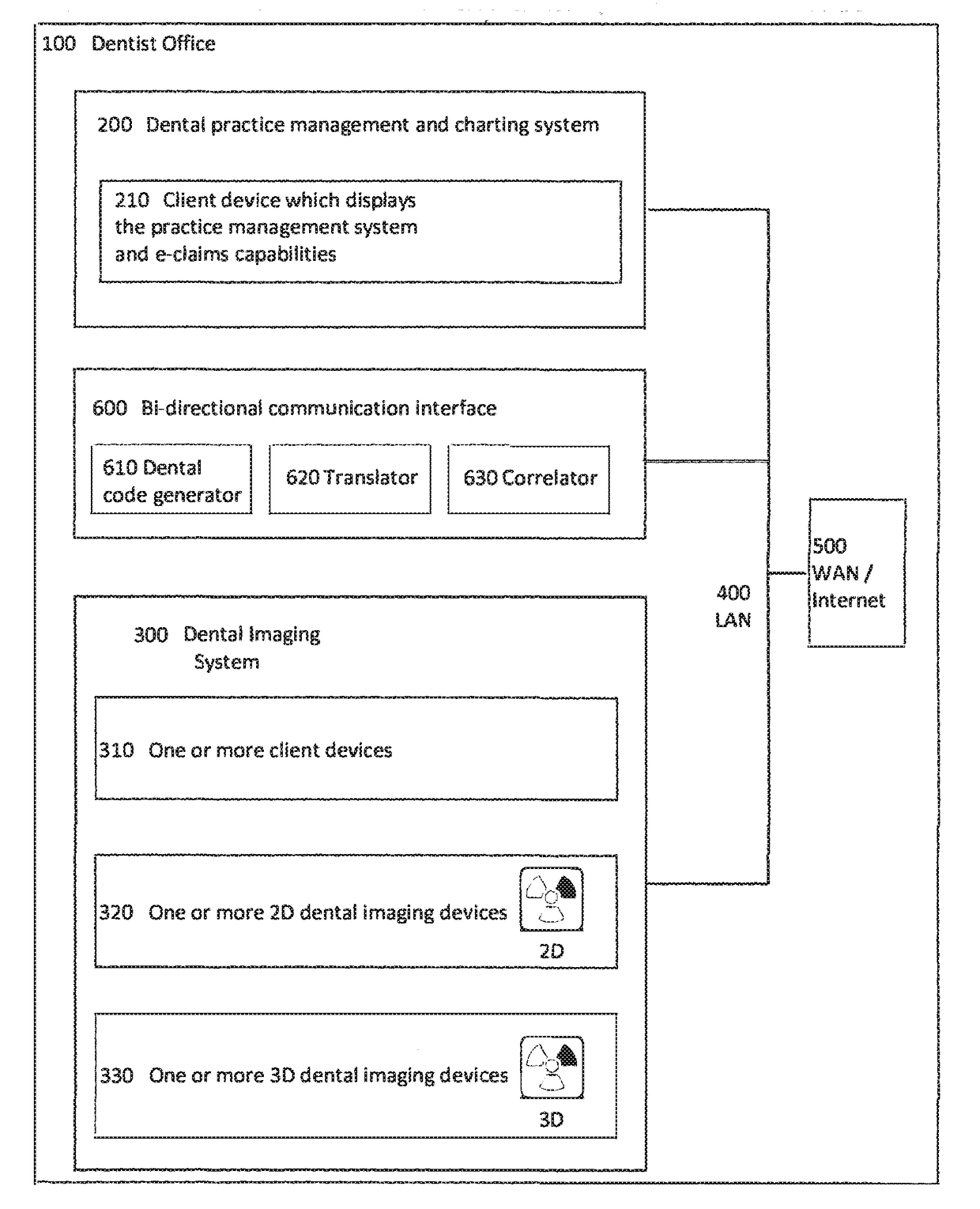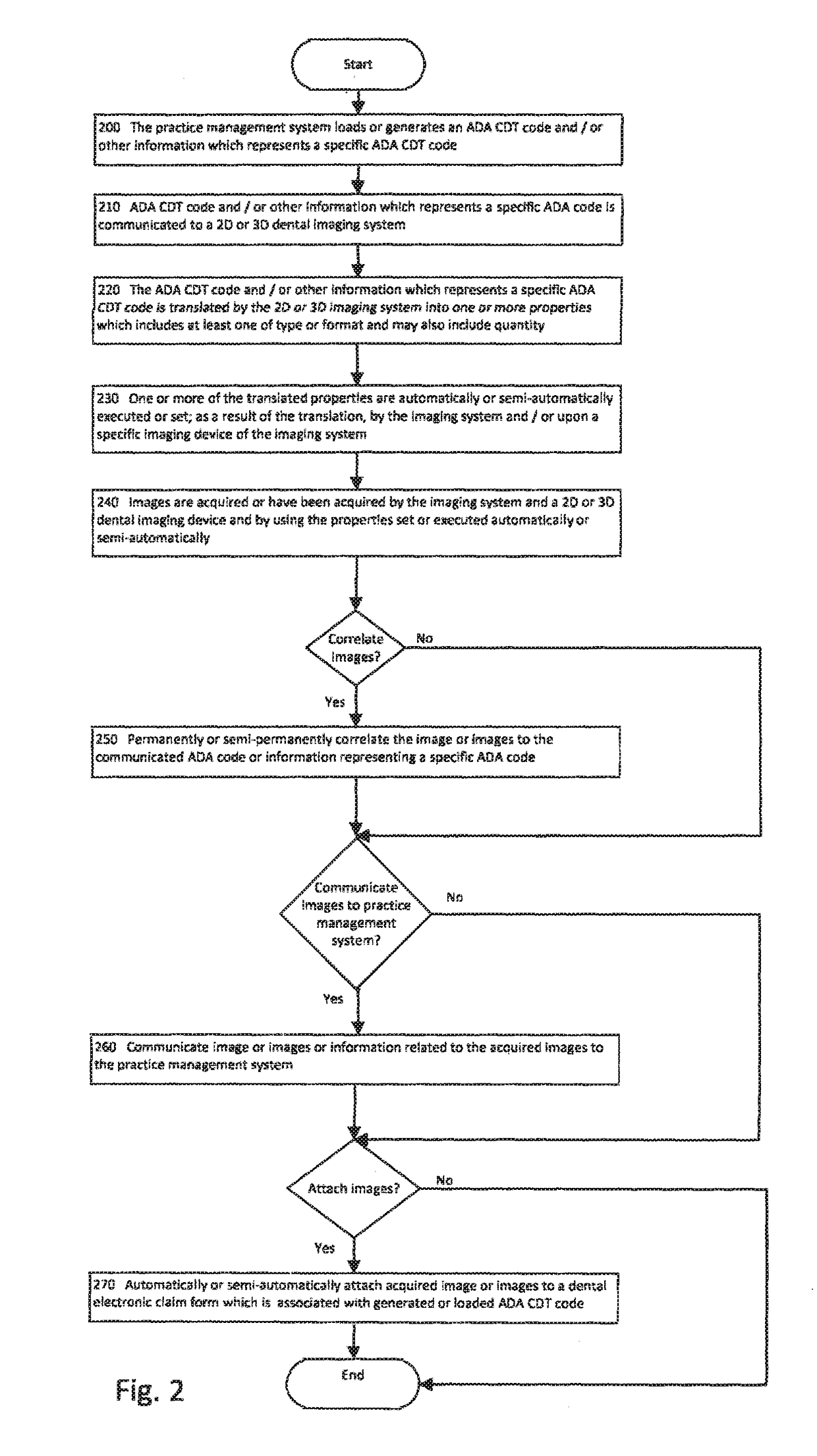There has been minimal integration of these two disparate systems and this has limited the capability of such systems when used by dentists and their staff.
This
scenario is repeated over and over for a normal dental practice and is tedious and requires many steps, and has added complexities by requiring use of multiple systems with disparate workflows, all of which lead to this method being cumbersome and mistake prone.
When a patient changes physicians, unfortunately, absent making a copy of the patient's medical records and transporting the copy to the next physician, there is no easy way to provide a new physician access to the patient's prior
medical history.
Unfortunately, since no standards exist, compatibility, exchangeability and
accessibility of
medical information is not conventionally possible among health care providers.
While this
medical information may be very useful in the management of the patient, there is no conventionally available method for the
medical information to reach the entities that could help that patient (e.g., physician, hospital, public and provide entities, offices, and thirty party payers) in a timely fashion, as would be needed, particularly in the case of emergency
patient care needs.
However, the main problem of obtaining data when the physician, hospital, insurance company, or the patient needs it, in a timely fashion, has remained an obstacle.
Most medical records are currently stored in a doctor's office, hospital, or a
database that are not always accessible to the patient when the patient or patient's health
care giver need the information.
While most records may be in a physician's office or a hospital, and some few medical records are stored in an electronic or digital
medical record system, very few doctors, patients, hospitals, or insurance providers have access to these medical records in an urgent setting, especially if the patient is traveling, away from the patient's
residence and normal health care provider.
Another problem with conventional electronic medical records is that conventional
medical record databases are generally redundant and incomplete.
Updating and maintaining the databases is labor intensive and usually the
database serves certain designated purposes for which it was programmed rather than being a complete
medical record for the patient.
Current physicians' lack of access to a patient's past medical records is a leading challenge in treating patients referred for care by a consultant.
For numerous reasons, such as office closings or inability to locate the chart in a timely manner, duplicate testing, and diagnosis may occur as a result of lack of access to critical medical information of the patient.
Access to information is also hindered by the fact that even when having access to pertinent medical information, the sheer volume of information in conventional records makes cumbersome the access of critical information from medical records.
The dispersion of a patient's medical records can make it difficult to identify and correct such potential undesirable
drug interactions.
Even in cases where all of the relevant records are co-located, a physician or
pharmacist may still miss the potentially harmful interactions.
Further, the distribution and inaccessibility of a patient's whole health and medical
record, combined with limited time for
office visits, may prevent a treating health care provider from being able to identify secondary issues that may aid in diagnosis and treatment.
These alternatives, however, limit editing of the images and are not very dynamic.
These systems provide better data manipulation, but can cost more than $20,000.00, and thus not affordable for a small or cost-limited practice.
Automating this management is a difficult task.
Previous attempts to automate
business practice asset management has led to a number of expensive, inadequate, mismatched tools that quickly become obsolete.
Currently a significant communication breakdown across general and dental specialist providers (endodontists, orthodontists, etc.) exists in the form of limited shared mutual
patient treatment information.
At present, most dental practices use differing practice management
software specific to their particular needs and as such the method of sharing such information is restricted to phone, fax, email, postal mail or patient delivery.
The healthcare industry today is a complicated and fragmented system.
As a result, people will tend to use such healthcare providers that have no relationship with one another, which results in fragmented healthcare management.
This can lead to redundancy of paperwork, increased
human error, which in turn can lead to mistakes in providing care, for example when one healthcare
service provider does not have a complete
record of a patient's
medical history and makes an incorrect diagnosis or recommendation as a result.
It is estimated that 20% of diagnostics are redundant since the required information is not in the right place at the right time.
These issues also lead to
delay in obtaining treatment.
As a result, many people will not seek appropriate
medical treatment (including preventative care and maintenance) because it is too inconvenient, cumbersome, confusing, and time-consuming.
The patient-specific issues mentioned above are also problematic from the viewpoint of the healthcare
service provider.
In addition, the healthcare
service provider is usually paid by a health insurance company or other
third party (such as a credit union), which adds many more problems such as inordinate delays in getting paid, increased paperwork, and even non-payments in some cases.
This increases the cost of providing services and takes away the providers' time that could otherwise be spent tending to their patients.
Healthcare insurers also face problems such as insurance fraud (for example where claims are made for services not rendered, excessive testing, improper prescriptions, etc.) and the increased cost of
processing the insurance claims from the healthcare service providers as well as patients.
Healthcare service centers such as hospitals, as well as their patients, also face similar problems.
Persons desiring to obtain
medical care, for example in an emergency situation, often encounter long delays in getting appropriate treatment.
Delays such as these can have significant consequences in situations where care must be immediately provided.
High administrative costs for filing and
processing health insurance claims have been the bane of the health insurance industry from its inception.
There were many virtues to these early systems, primarily with respect to decreased administrative costs, but a major drawback was that the data for each “paper” claim had to be entered into the computer to form an electronic claim.
Although the idea was straightforward, implementation was not.
Second, a majority of providers have to be able to interface with a majority of insurance companies, i.e., insurance company mainframe computers.
However, because of the way computers had entered the insurance industry originally (stage #2), there was no industry-wide standard, i.e., the legacy mainframe computers of the different insurance companies were incompatible.
But there are many claims that do not meet these conditions.
But transforming the
medical evidence into digital form is not enough to facilitate electronic
processing of claims with attachments.
First, NEIC does not at the present time allow this type of information to be transmitted through NEIC to the insurance companies.
Second, with the current system, the claims adjusters access claims information through terminals connected to mainframes.
But there is the inherent problem of displaying images on mainframe computers.
This results in a massive
interfacing problem since there are multitudes of insurance companies using different legacy hardware systems and company unique
software.
Each time a way has been found to more fully utilize computers in claims processing systems, the administrative costs associated with claims processing have gone down.
However, in the area of “claims with attachments,” no coherent industry-wide system exists that allows for the integrated filing, transmitting and processing of these claims electronically, i.e., via computers.
This
hybrid system, which is described in greater detail below, is labor intensive, prone to problems, and slow.
For providers, insurance companies, and patients, this is a time-consuming, costly and irritating process.
In fact, there are even difficulties with the second stage.
However, the presence of a film x-
ray means that electronic claims methods cannot be implemented.
The savings associated with electronic claim processing is not available with respect to Prior Approval Claim forms.
However, since an attachment is not normally associated with the Final Claim Form, additional discussion regarding disposition of the Final Claim Form within the insurance company will not be provided.
It will be appreciated that a myriad of problems and inefficiencies arise due to claim processing in accordance with the
hybrid system.
This is the source of a great many of the above described problems.
Moreover, the current
hybrid method is costly.
Furthermore, the whole process is filled with potential for error,
frustration, wasted time and money.
Regardless of these differences, there are similarities in the problems that arise in processing such claims.
Diagnostics and
documentation are hampered by the fact that the users are forced, when performing further actions, to resort not to individual but to general diagrams such as the standard tooth scheme on the health insurance
certificate.
The solution to this problem is at present either inadequate or complicated since it is only possibly to select either entire conventional fixed groups of teeth or only individual teeth.
In all cases the contact with reality is lost, since the user must leave his usual environment, e.g., a real
dentition radiogram.
Acquisition thereof is complicated, because as a rule the user no longer has direct contact with his accustomed environment of a panoramic image.
Dentists often do not have
electronic access to the charting information they need in the operatory or lab environment itself.
However, these various paper-based sources are difficult to analyze together in a meaningful fashion.
 Login to View More
Login to View More  Login to View More
Login to View More 


